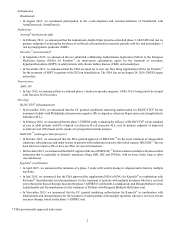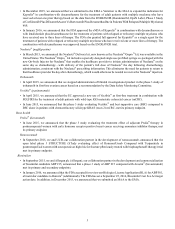Amgen 2015 Annual Report Download - page 20
Download and view the complete annual report
Please find page 20 of the 2015 Amgen annual report below. You can navigate through the pages in the report by either clicking on the pages listed below, or by using the keyword search tool below to find specific information within the annual report.12
promotional context. The FDA may take enforcement action against a company for promoting unapproved uses of a product or
for other violations of its advertising and labeling laws and regulations. Enforcement action may include product seizures,
injunctions, civil or criminal penalties or regulatory letters, which may require corrective advertising or other corrective
communications to healthcare professionals. Failure to comply with the FDA’s regulations also can result in adverse publicity or
increased scrutiny of company activities by the U.S. Congress or other legislators. Additionally, as described below, such failure
may lead to additional liability under U.S. health care fraud and abuse laws.
Regulation of Manufacturing Standards. The FDA regulates and inspects equipment, facilities, laboratories and processes
used in the manufacturing and testing of products prior to providing approval to market products. If after receiving approval from
the FDA, we make a material change in manufacturing equipment, location or process, additional regulatory review may be
required. We also must adhere to current Good Manufacturing Practice regulations and product-specific regulations enforced by
the FDA through its facilities inspection program. The FDA conducts regular, periodic visits to re-inspect our equipment, facilities,
laboratories and processes following an initial approval.
Regulation of Combination Products. Combination products are defined by the FDA to include products comprised of two
or more regulated components (e.g., a biologic and/or drug and a device). Biologics/Drugs and devices each have their own
regulatory requirements, and combination products may have additional requirements. A number of our marketed products meet
this definition and are regulated under this framework, and we expect that a number of our pipeline product candidates will be
evaluated for regulatory approval under this framework as well.
Regulation Outside the United States
In the EU countries, Switzerland, Canada, Australia and Japan, regulatory requirements and approval processes are similar
in principle to those in the United States. In the EU, depending on the type of drug for which approval is sought, there are currently
two potential tracks for marketing approval, a decentralized and centralized procedure. In the decentralized procedure, identical
applications for marketing authorization are submitted simultaneously to the national regulatory agencies. The application is
assessed by an initial national agency (Reference Member State) and the subsequent countries that the applicant chooses to seek
approval (Concerned Member States). Regulatory review is led by the Reference Member State and acknowledged by the Concerned
Member States leading to a single approval in all relevant countries. In the centralized procedure, which is required of all products
derived from biotechnology, a company submits a single MAA to the EMA, which conducts a thorough product evaluation, drawing
from its scientific resources across Europe. If the drug product is proven to fulfill the requirements for quality, safety and efficacy,
the Committee for Medicinal Products for Human Use (CHMP) adopts a positive opinion, which is transmitted to the EC for final
approval of the marketing authorization. While the EC generally follows the CHMP’s opinion, it is not bound to do so. Subsequent
commercialization is enabled by country-by-country reimbursement approval. In Japan, additional local clinical trials may be
required as part of the drug registration process, which can add to the drug registration timelines.
In the EU, biosimilars have been approved under a specialized pathway of the centralized procedure. As with the U.S.
pathway, sponsors of a biosimilar may seek and obtain regulatory approval based in part on the non-clinical and clinical trial data
of an originator product to which the biosimilar has been demonstrated to be “similar.”
Other countries such as Russia, Turkey and those in Latin America and the Middle East have review processes and data
requirements similar to those of the EU, and in some cases rely on prior marketing approval from U.S. or EU regulatory authorities.
The regulatory process in these countries may include manufacturing/testing facility inspections, testing of drug product upon
importation and other domestic requirements.
In Asia, a number of countries such as China, South Korea and Taiwan may require local clinical trials as part of the drug
registration process in addition to the global clinical trials which can add to the drug registration timelines. In most Asian markets,
registration timelines are dependent on marketing approval in the United States or EU. However, in some emerging markets in
Asia, such as China, the regulatory landscape is evolving and the regulatory timelines can be less predictable.
Post-approval Phase
After approval, we continue to monitor adverse events reported following the use of our products through post marketing
routine pharmacovigilance surveillance and studies when applicable. We report such events to the appropriate regulatory agencies,
as required per local regulations for individual cases and aggregate reports. We proactively monitor (according to good
pharmacovigilance practices) and ensure the implementation of signal detection, assessment and communication of adverse events
that may be associated with the use of our products. We may also be required by regulatory agencies to conduct further clinical
trials on our marketed products as a condition of their approval or to provide additional information on safety and efficacy. Health
authorities, including the FDA, have authority to mandate labeling changes to products at any point in a product’s lifecycle based
on new safety information or as part of an evolving label change to a particular class of products.
























